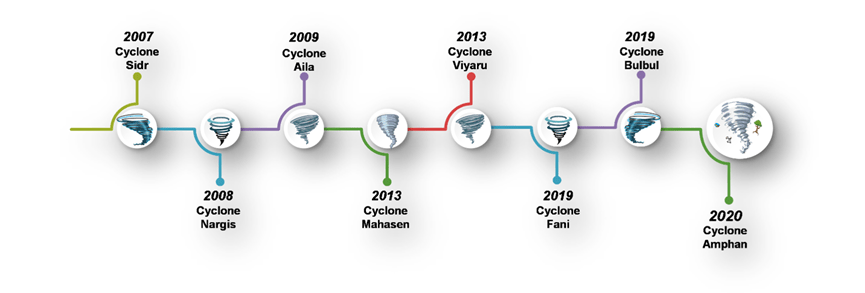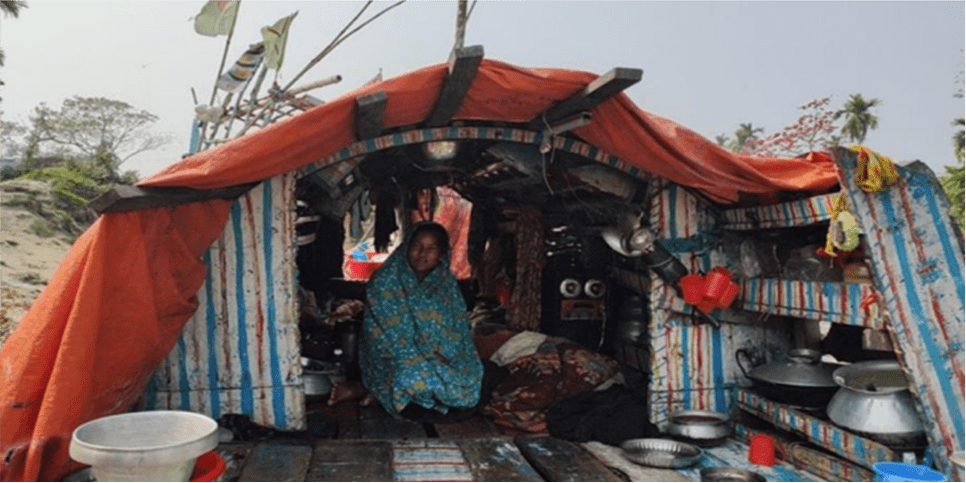Photo credit: Plan International
Women in Bangladesh face a range of stark inequalities, and these impact the participation of women and girls when disaster strikes, as detailed in this study. Rapid Asia conducted the study on behalf of Plan International, as part of their Inclusive Community Disaster Risk Reduction and Management (ICDRM) project, aiming to increase the participation of women, girls, and marginalized groups in disaster risk management (DRM).
“Men go to the cyclone center first and tell the women that ‘I will call you if the situation gets worse. Then you get packed and come to the center. Without my permission do not go anywhere.’”
— Female member, ward disaster management committee (WDMC) Behduria
Gender inequality manifests in several ways, including through constrained freedom of movement and lack of economic autonomy. Women and girls in the study reported various reasons for staying at home, including during disasters when staying at home can place them at enormous risk. Cultural practices, including the social institution of purdah (seclusion), mean that Muslim women and girls in some areas are expected to stay in the home carrying out domestic duties, and to seek the permission of their husband or father to leave the house, even during floods or cyclones (see Figure 1 for timeline of cyclones in Bhola). Connected to this, respondents reported fearing violent attack by men in public spaces, such as cyclone centers; spaces where there are often no private spaces designated for women. At home, studies show that there is a clear link between natural disasters and increased gender-based violence (GBV); GBV increased by 65% in the affected areas after cyclone Amphan. When going out, even women’s clothing poses a genuine risk during disasters; women can be dragged down in floods by their billowing dress, and cannot (unlike men) simply take it off in public spaces. Women in the focus areas already have limited economic autonomy and if this is lost during a disaster it is likely the household returns to the ‘default’ of resource management sitting with the male ‘head.’
“Men basically work outside and arrange money and food for the family. As they earn money, they are the owner, master, or you can say, leader of the family.”
— Female member, WDMC Bheduria

Figure 1: Cyclone timeline in Bhola
Rigid and unequal gender roles serve as some of the key barriers to women and girls participating in DRM. Due to religious doctrine, perceived biological inequalities, and societal norms, women are seen as weaker than men and as something to be protected, and are thus largely excluded from public life and decision-making control within the household over money, information, communication, and sources of food. This lifelong exclusion has drastic consequences if disaster strikes; it has been estimated that during the 1991 cyclone in Bangladesh the death rate for women was five times higher than that of men. The division of life into private and public spheres is one of the main barriers inhibiting women’s participation in DRM, linking to women and girls being seen as responsible for all care duties, women not feeling that their opinion in public meetings is valuable, and men’s dominance in society blocking pathways for increased women’s decision-making.
“Of course, women should participate as they are half of the nation.”
—Woman from Kachia with no involvement in DRM
Despite the many challenges outlined above, participatory assessments with disaster management groups throughout the Bhola district have shown that all groups have been able to roughly achieve gender parity in their participation. Respondents reported the positive impacts of this, including changing perceptions through seeing other women speak up (even if most do not), greater awareness of women’s rights, and a practical recognition that women and girls suffer most from disasters, thus should be prepared for how to respond. Informants even reported that the trainings have had a demonstrable impact on women’s leadership and decision-making within their communities, with women taking active roles ensuring that households are prepared and that everyone, including marginalized groups, knows how to get to evacuation centers and feels safe taking shelter in them.
The inclusion and participation of women, girls, and other marginalized groups in DRM clearly has beneficial outcomes across the board, in terms of implementing more effective emergency responses that reach all members of a community, and in the longer-term working towards building greater capacity and acceptance of women in decision-making roles in society more generally.
The full report, the Study on Women and Girls’ Participation in Communication Risk Management in Bangladesh can be found here.
About the authors: Daniel Lindgren is the Founder of Rapid Asia Co., Ltd. a management consultancy firm based in Bangkok that specialises in evaluations for programs, projects, social marketing campaigns and other social development initiatives. Leilana Quinger is an independent consultant working with Rapid Asia as a member of their expert panel of consultants.

